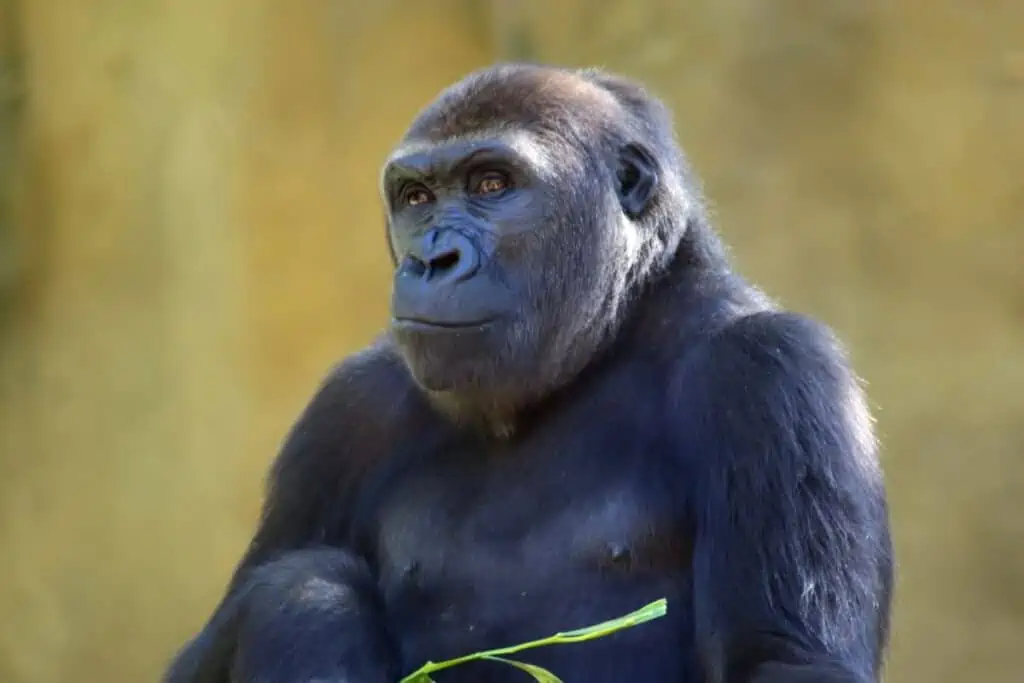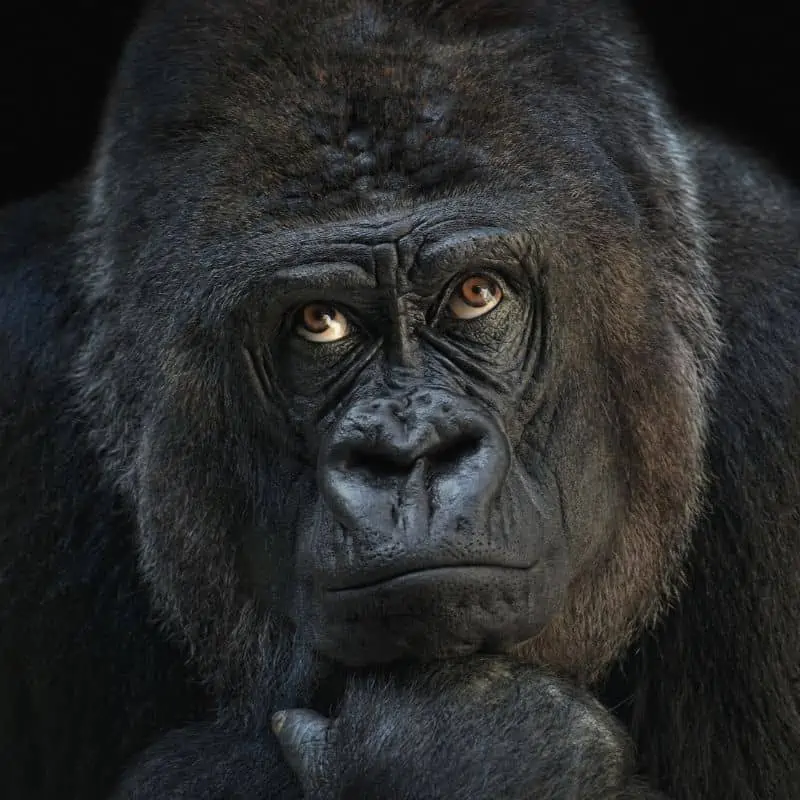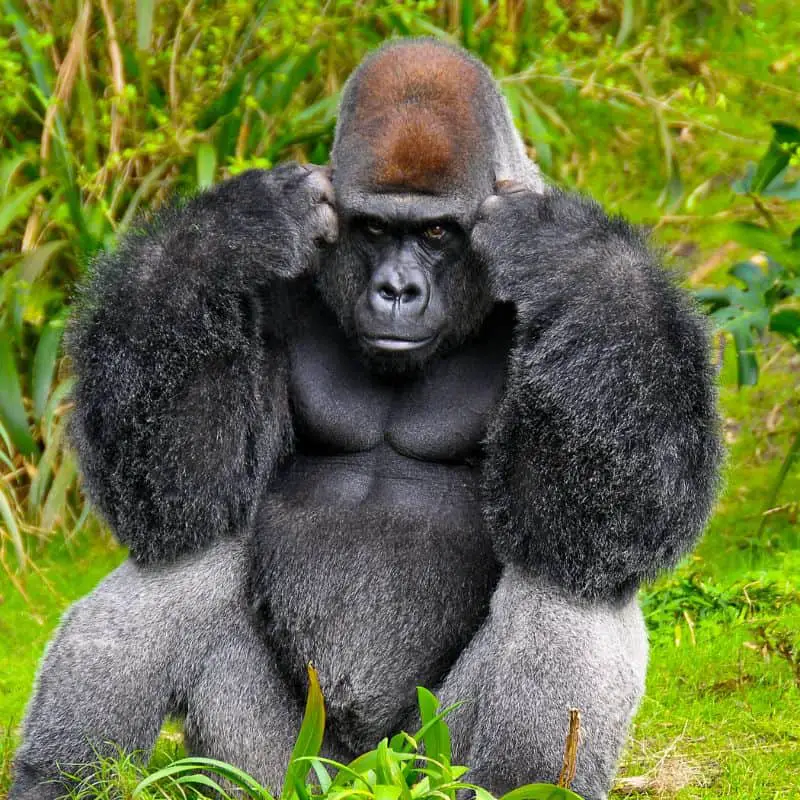As gorillas share many similarities with humans, it’s natural to question whether they are intelligent and how smart they are compared to other species of apes. Assessing intelligence is also easier said than done as gorillas are physically stronger than chimpanzees resulting in a more dominant use of muscles than neurons. However, that does not necessarily make them less intelligent.
Gorillas are smart and known for using tools to more effectively complete tasks and vocalization to communicate, making them intelligent, although ape species vary greatly in intelligence. For example, Gorillas are not as curios or adaptable as chimpanzees and do not tend to imitate.
A basic understanding of communication and using tools is not the most satisfactory sign of intelligence for some scientists though, resulting in them experimenting with the consciousness of gorillas.
Some scientists were interested to see whether gorillas are conscious of themselves and can ‘wonder’ about their surroundings and conditions.

Do gorillas have a sense of consciousness?
When assessing the intelligence of gorillas, it’s nearly impossible to ignore the developments made by the female gorilla ‘Koko.’ Before delving into the extraordinary steps Koko took, it’s important to note that gorillas form part of the ‘great apes,’ meaning they are included in the species of four classifications known as ‘Pongo,’ ‘Gorilla,’ ‘Pan,’ and ‘Homo.’
As a result, they share a very strong biological link with humans meaning intelligence is a noticeable characteristic, but do they have consciousness the same way humans do?
Generally speaking, gorillas, like all great apes, are aware of their surroundings and are known to interpret them in different ways. As the species differ in their intellectual ability, they have different ways of adapting and thinking about the environment.
Some gorillas have formed different groups of cultures, managing their families in different ways and even having different food preparation rituals; others have preferred specific colors. Although some researchers have claimed that gorillas also have religious thoughts and ideals, what we do know for certain is that they have strong emotions.

Gorillas can feel many emotions ranging from grief to happiness and are, in some rare cases, like Koko, even able to describe their emotions (more on this later). They commonly vocalize communicating on a basic level to indicate danger or other primitive messages.
On the other hand, gorillas have a strong sense of awareness and understanding regarding ‘family management’ and enjoy various activities together, like playing, sleeping, and eating.
The results were contradictory and varied regarding consciousness of their own being.
During an experiment, gorillas were given a mirror to deduce whether they recognized themselves and were aware of their own ‘being’ in their surroundings; unfortunately, some gorillas were well aware of themselves, while others were utterly clueless.
Are gorillas smart enough to speak?
One cannot refer to the intelligence of gorillas and ignore Koko. During the 1970s, researcher Francine Patterson sought to teach Koko, the female gorilla, sign language and succeeded in more ways than one.
The vocalization of gorillas is quite a notable characteristic, and they can communicate using more than twenty-five types of distinctive vocalizations. Most of these unique forms of vocalization are only used for important messages like contentment and anger or, more broadly, messages concerning family management and food gathering.
However, teaching gorillas how to speak would prove a far more advanced challenge; therefore, Francine instead focused on three simple hand signs referring to ‘food,’ ‘drink,’ and ‘more.’
Within the first three months, Koko could use more than sixteen distinctive sign combinations and even started forming basic questions utilizing body language and eye contact.

According to Patterson’s research, Koko not only mimicked, but understood and used more than 1000 signs to communicate with her and other colleagues. Patterson mentioned that although Koko couldn’t necessarily ‘speak’ English words, she could connect them, expressing different statements, including her wants, needs, and thoughts.
It’s vital to know that although gorillas can learn sign language and interpret words, the only record of this is when the animal was secluded and trained with that particular goal in mind, as it’s not common for them to do so by themselves (mostly because it’s not vital to their survival).
In addition, Patterson started training when Koko was six months old, and it took nearly ten years before Koko effectively mastered five-hundred signs.
Furthermore, Koko could only correctly use 1000 signs once, and her dialogues often had to be interpreted, making other scientists skeptical and unconvinced of Koko’s intelligence.
Are gorillas smart enough to make and use tools?
Another tell-tale sign of intelligence is when animals can use their surroundings and ‘tools’ to do tasks more effectively. Of course, creating tools for a specific purpose will be a more prominent indicator of intellect. Still, gorillas have been sighted using objects found in nature to serve a purpose and even, in rare cases, manipulate them slightly.
Sightings of gorillas using tools were mentioned on record by the researcher Thomas Breuer’ during an expedition in 2005. One example was a female gorilla using a stick to test the depth of the water while crossing over a swamp; another female gorilla used a tree stump for support while fishing and as a bridge for crossing as gorillas can’t swim.
Moreover, a baby gorilla was also spotted breaking nuts with a rock. Both female gorillas were spotted using tools in the ‘Republic of Congo’ in the Nouabalé-Ndoki National park, whereas the baby was spotted in a game sanctuary.

Years later, in 2009, at a different location called ‘Buffalo Zoological Gardens,’ four adult gorillas (three female and one male) were given buckets near a pool to test whether they would use them to collect water.
Only two of the female gorillas used the buckets to drink water, but it’s unlikely that they would have searched for an object capable of holding water if the buckets were not provided.
Although gorillas don’t often use tools as the food they consume, like plants, requires little effort to obtain, there were rare cases where they manipulated tools for a specific purpose.
For example, a gorilla has been spotted breaking rocks and using sharp pieces to scrape bits of bark off a tree for consumption.
Unlike chimpanzees, gorillas sleep on the ground in self-made nests. As a result, gorillas manipulated various objects to form a comfortable nest for resting and sleeping.
How smart are gorillas compared to other apes?
The ‘Great apes’ are scientifically known as ‘Hominidae,’ whose species are categorized into four groups known as ‘Genera.’ The Four Genera are Pongo (Orangutan), Gorilla (eastern and western), Pan (Chimpanzee and Bonobo), and Homo (humans).
It’s no secret which genera are now considered the most intelligent, but the psychologist ‘Robert Deaner’ wanted to asses and conclusively state which non-human primate specie is the smartest.
To deduce which species is the smartest, Deaner created nine tests focused on different cognitive abilities while trying to avoid the core differences of the animals that will give them a natural advantage.
As a result, the tasks included navigating through mazes and solving tangled puzzles.
Still, the results were unfortunate as most of them did poorly on some tasks and even worse at others; nevertheless, some species did prove to be more capable considering the overall tests, and the outcome was the following (in order):
Orangutan, Chimpanzee, Spider monkey, Gorilla, Surili, Macaque, Mandril, Guenon, Mangabey, and Capuchin.
The experiment also yielded two critical facts; firstly, the absolute brain size is more important than the brain size adjusted to the body size. Secondly, species that lived longer (like the great apes) were more intelligent than the subspecies that developed later.
Final thoughts on how smart gorillas are
Although some researchers are not convinced of gorillas’ “human-like intelligence,” gorillas are highly intelligent compared to other animal species.
They have methods of communicating and manipulating objects indicating they are smart enough to take advantage of their surroundings and show many emotions.
While these critically endangered animals may not be as intelligent as humans, they are much smarter than we give them credit.
